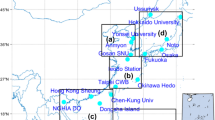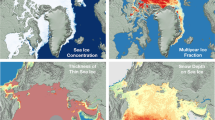Abstract
The SAAWSO (Satellite Applications for Arctic Weather and SAR (Search And Rescue) Operations) field programs were conducted by Environment Canada near St. Johns, NL and Goose Bay, NL in the winters of 2012–13 and 2013–14, respectively. The goals of these programs were to validate satellite-based nowcasting products, including snow amount, wind intensity, and cloud physical parameters (e.g., cloud cover), over northern latitudes with potential applications to Search And Rescue (SAR) operations. Ground-based in situ sensors and remote sensing platforms were used to measure microphysical properties of precipitation, clouds and fog, radiation, temperature, moisture and wind profiles. Multi-spectral infrared observations obtained from Geostationary Operational Environmental Satellite (GOES)-13 provided estimates of cloud top temperature and height, phase (water, ice), hydrometer size, extinction, optical depth, and horizontal wind patterns at 15 min intervals. In this work, a technique developed for identifying clouds capable of producing high snowfall rates and incorporating wind information from the satellite observations is described. The cloud top physical properties retrieved from operational satellite observations are validated using measurements obtained from the ground-based in situ and remote sensing platforms collected during two precipitation events: a blizzard heavy snow storm case and a moderate snow event. The retrieved snow precipitation rates are found to be comparable to those of ground-based platform measurements in the heavy snow event.

















Similar content being viewed by others
References
Auer, A. H., JR., AND J. M. White, 1982: The combined role of kinematics, thermodynamics and cloud physics associated with heavy snowfall episodes. J. Japan Met. Soc., 60, 500-507.
Benjamin, S.G., D. Devenyi, S.S. Weygandt, K.J. Brundage, J.M. Brown, G.A. Grelll, D. Kim, B.E. SCHWARTZ, T.G. SMIRNOVA, T.L. SMITH, and G.S. Manikin, 2004: An hourly assimilation/forecast cycle: The RUC. Mon. Wea. Rev., 132, 495-518.
Boukabara, S.-A., K. Garrett, W. Chen, F. Iturbide-Sanchez, C. Grassotti, C. Kongoli, R. Chen, Q. Liu, B. Yan, F. Weng, R. Ferraro, T. Kleespies, and H. Meng., 2011: An All-Weather 1DVAR Satellite Data Assimilation and Retrieval System. IEEE Trans. Geosci. Remote Sens., 49, 9, 3249-3272.
Doviak, R.J., and D.S. Zrnic, 1993. Doppler Radar and Weather Observations, Academic Press. Second Edition, San Diego CA. 562 pp.
Gultepe, I., T. Kuhn, M. Pavolonis, C. Calvert, J. Gurka, G.A. Isaac, A. J. Heymsfield, P.S.K. Liu, B. Zhou, R. Ware, B. Ferrier, J. Milbrandt, B. Hansen, and B. Bernstein, 2014: Ice fog in Arctic during FRAM-IF project: Aviation and nowcasting applications. Bull. Amer. Met. Soc., 95, 211–226.
Gultepe, I., B. Zhou, J. Milbrandt, A. Bott, Y. LI, A. J. Heymsfield, B. Ferrier, R. Ware, M. Pavolonis, T. Kuhn, J. Gurka, P. Liu, and J. Cermak, 2015: A review on Ice Fog Measurements and Modeling. Atmos. Res.. 151, 2-19.
Hayden, C.M., R. J. Purser, 1995: Recursive filter objective analysis of meteorological fields, applications to NESDIS operational processing. J. Appl. Meteor., 34, 3-15.
Hou, A.Y., R. K. Kakar, S. Neeck, A. A. Azarbarzin, C. D. Kummerow, M. Kojima, R. Oki, K. Nakamura, and T. Iguchi, 2014: The Global Precipitation Measurement Mission. Bull. Amer. Meteor. Soc., 95, 701–722.
Kadin, C., 1982: The Minneapolis Snow Event—What Did The Satellite Imagery Tell Us? National Wea. Digest, 7, 3, 13-16.
Kuligowski, R.J., 2002: A Self-Calibrating Real-Time GOES Rainfall Algorithm for Short-Term Rainfall Estimates. J. Hydrometeorology, 3, 112–130
Kuligowski, R.J., Y. LI, and Y. Zhang, 2013: Impact of TRMM data on a low-latency, high-resolution precipitation algorithm for flash-flood forecasting. J. Appl. Meteor. Cli., 6, 1379-1393.
Kuligowski, R.J. Y. Li, Y. Hao and Y. Zhang, 2015: Improvements to the GOES-R Rainfall Rate Algorithm. Submitted to the J. Hydrometeorology
Liu, Q., and F. Weng, 2005: One-dimensional retrieval algorithm of temperature, water vapor, and cloud water profiles from advanced microwave sounding unit (AMSU). IEEE Geosci. Remote Sensing, 43, 5, 1087-1095.
Olson, W.S., C.D. Kummerow, G.M. Heymsfield, L. Giglio, 1996: A method for combined passive-active microwave retrievals of cloud and precipitation profiles. J. App. Meteor., 35, 1763-1788.
McMurdie, L.A., and K. B. Katsaros, 1991: Satellite-derived integrated water vapor distribution in oceanic midlatitude storms: Variation with region and season. Mon. Wea. Rev., 119, 589-605.
Rabin, R.M., S.F. Corfidi, J.C. Bunner, C.E. Hane, 2004: Detecting winds aloft from water vapour satellite imagery in the vicinity of storms. Weather, 59, 251-257.
Rabin, R.M., J. Hanna, 2008: GOES winter precipitation efficiency algorithm. Fifth GOES Users Conference. American Meteorological Society. P1.34.
Rasmussen, R.,M. Dixon, S. Vasiloff, F. Hage, S. Knight, 2003: Snow nowcasting using a real-time correlation of radar reflectivity with snow gauge accumulation. J. Appl. Meteor., 42, 20-36.
Roebeling, R., B. Baum, R. Bennartz, U. Hamann, A. Heidinger, A. Thoss, A. Walther, 2013: Evaluating and Improving Cloud Parameter Retrievals. Bull. Amer. Meteor. Soc., 94, ES41–ES44.
Scofield, R. A., 1987: The NESDIS operational convective precipitation estimation technique. Mon. Wea. Rev., 115, 1773-1792.
Scofield, R. A., and R. J. Kuligowski, 2003: Status and outlook of operational satellite precipitation algorithms for extreme-precipitation events. Mon. Wea. Rev., 18, 1037-1051.
Steigerwaldt, H., 1986: Deformation zones and heavy precipitation. Natl. Wea. Dig., 11:1, 15-20.
Van Baelen, J., M. Reverdy, F. Tridon, L. Labbouz, G. Dick, M. Bender and M. Hagen, 2011: On the relationship between water vapour field evolution and the life cycle of precipitation systems. Q.J.R.Meteorol.Soc., 137, 204-223.
Velden, C. S., J. Daniels, D. Stettner, D. Santek, J. Key, J. Dunion, K. Holmlund, G. Dengel, W. Bresky, and P. Menzel, 2005: Recent Innovations in Deriving Tropospheric Winds from Meteorological Satellites. Bull. Amer. Meteor. Soc., 86, 205-223.
Vicente, G. A., R. A. Scofield, and W. P. Menzel, 1998: The operational GOES infrared rainfall estimation technique. Bull. Amer. Meteor. Soc., 79, 1883- 1898.
Walther, A., and A.K. Heidinger, 2012: Implementation of the Daytime Cloud Optical and Microphysical Properties Algorithm (DCOMP) in PATMOS-x. Journal of Applied Meteorology and Climatology. 51, 1371-1390.
Wetzel, S.W., and J. E. Martin, 2001: An Operational Ingredients-Based Methodology for Forecasting Midlatitude Winter Season Precipitation. Wea. Forecasting, 16, 156–167.
Won, H.Y., Y.-H., Kim, and H.S. Lee, 2009: An application of brightness temperature received from a ground-based microwave radiometer to estimation of precipitation occurrences and rainfall intensity. Asia-Pacific J. Atmos. Sci., 45, 55-69.
Acknowledgments
The authors wish to thank Environment Canada for support of the data collection programs, Dr William Straka (University of Wisconsin-CIMSS) for providing the GOES cloud top property data, and the GOES-R program for support in development of the SCaMPR algorithm. The Man Computer Interactive data Analysis System (McIDAS) University of Wisconsin-Madison, Space Science and Engineering Center was used for much of the data processing and visualization. This study was funded during the 2012–2015 time period by through the National Search and Rescue Secretariat (SAR) of Canada under the Search and Rescue New Initiatives Fund (SAR NIF). The authors also would like to thank Environment Canada for technical support and additional funds for this project.
Author information
Authors and Affiliations
Corresponding author
Rights and permissions
About this article
Cite this article
Rabin, R.M., Gultepe, I., Kuligowski, R.J. et al. Monitoring Snow Using Geostationary Satellite Retrievals During the SAAWSO Project. Pure Appl. Geophys. 173, 3085–3102 (2016). https://doi.org/10.1007/s00024-015-1195-6
Received:
Revised:
Accepted:
Published:
Issue Date:
DOI: https://doi.org/10.1007/s00024-015-1195-6




